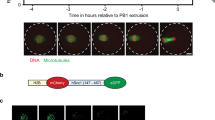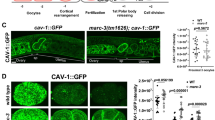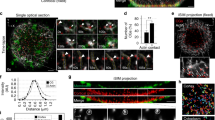Abstract
Vertebrate eggs awaiting fertilization are arrested at metaphase of meiosis II by a biochemical activity termed cytostatic factor (CSF)1,2. This activity inhibits the anaphase-promoting complex/cyclosome (APC/C), a ubiquitin ligase that triggers anaphase onset and mitotic/meiotic exit by targeting securin and M-phase cyclins for destruction3,4,5. On fertilization a transient rise in free intracellular calcium6 causes release from CSF arrest and thus APC/C activation. Although it has previously been shown that calcium induces the release of APC/C from CSF inhibition through calmodulin-dependent protein kinase II (CaMKII)7,8, the relevant substrates of this kinase have not been identified. Recently, we characterized XErp1 (Emi2), an inhibitor of the APC/C and key component of CSF activity in Xenopus egg extract9. Here we show that calcium-activated CaMKII triggers exit from meiosis II by sensitizing the APC/C inhibitor XErp1 for polo-like kinase 1 (Plx1)-dependent degradation. Phosphorylation of XErp1 by CaMKII leads to the recruitment of Plx1 that in turn triggers the destruction of XErp1 by phosphorylating a site known to serve as a phosphorylation-dependent degradation signal. These results provide a molecular explanation for how the fertilization-induced calcium increase triggers exit from meiosis II.
This is a preview of subscription content, access via your institution
Access options
Subscribe to this journal
Receive 51 print issues and online access
$199.00 per year
only $3.90 per issue
Buy this article
- Purchase on Springer Link
- Instant access to full article PDF
Prices may be subject to local taxes which are calculated during checkout




Similar content being viewed by others
References
Tunquist, B. J. & Maller, J. L. Under arrest: cytostatic factor (CSF)-mediated metaphase arrest in vertebrate eggs. Genes Dev. 17, 683–710 (2003)
Masui, Y. & Markert, C. L. Cytoplasmic control of nuclear behaviour during meiotic maturation of frog oocytes. J. Exp. Zool. 177, 129–145 (1971)
King, R. W. et al. A 20S complex containing CDC27 and CDC15 catalyzes the mitosis-specific conjugation of ubiquitin to cyclin B. Cell 81, 279–288 (1995)
Sudakin, V. et al. The cyclosome, a large complex containing cyclin-selective ubiquitin ligase activity, targets cyclins for destruction at the end of mitosis. Mol. Biol. Cell 6, 185–197 (1995)
Salah, S. M. & Nasmyth, K. Destruction of the securin Pds1p occurs at the onset of anaphase during both meiotic divisions in yeast. Chromosoma 109, 27–34 (2000)
Busa, W. B. & Nuccitelli, R. An elevated free cytosolic Ca2+ wave follows fertilization in eggs of the frog, Xenopus laevis. J. Cell Biol. 100, 1325–1329 (1985)
Lorca, T. et al. Degradation of the proto-oncogene product p39mos is not necessary for cyclin proteolysis and exit from meiotic metaphase: requirement for a Ca(2 + )-calmodulin dependent event. EMBO J. 10, 2087–2093 (1991)
Lorca, T. et al. Calmodulin-dependent protein kinase II mediates inactivation of MPF and CSF upon fertilization of Xenopus eggs. Nature 366, 270–273 (1993)
Schmidt, A. et al. Xenopus polo-like kinase Plx1 regulates XErp1, a novel inhibitor of APC/C activity. Genes Dev. 19, 502–513 (2005)
Fuchs, S. Y., Spiegelman, V. S. & Kumar, K. G. The many faces of beta-TrCP E3 ubiquitin ligases: reflections in the magic mirror of cancer. Oncogene 23, 2028–2036 (2004)
Descombes, P. & Nigg, E. A. The polo-like kinase Plx1 is required for M phase exit and destruction of mitotic regulators in Xenopus egg extracts. EMBO J. 17, 1328–1335 (1998)
Elia, A. E., Cantley, L. C. & Yaffe, M. B. Proteomic screen finds pSer/pThr-binding domain localizing Plk1 to mitotic substrates. Science 299, 1228–1231 (2003)
Elia, A. E. et al. The molecular basis for phosphodependent substrate targeting and regulation of Plks by the Polo-box domain. Cell 115, 83–95 (2003)
Holloway, S. L., Glotzer, M., King, R. W. & Murray, A. W. Anaphase is initiated by proteolysis rather than by the inactivation of maturation-promoting factor. Cell 73, 13393–13402 (1993)
Stemmann, O., Zou, H., Gerber, S. A., Gygi, S. P. & Kirschner, M. W. Dual inhibition of sister chromatid separation at metaphase. Cell 107, 715–726 (2001)
Colbran, R. J., Fong, Y. L., Schworer, C. M. & Soderling, T. R. Regulatory interactions of the calmodulin-binding, inhibitory, and autophosphorylation domains of Ca2+/calmodulin-dependent protein kinase II. J. Biol. Chem. 263, 18145–18151 (1988)
Zachariae, W. Emi1 and Erp1: who can stop these eggs? Dev. Cell 8, 301–303 (2005)
Ohsumi, K., Koyanagi, A., Yamamoto, T. M., Gotoh, T. & Kishimoto, T. Emi1-mediated M-phase arrest in Xenopus eggs is distinct from cytostatic factor arrest. Proc. Natl Acad. Sci. USA 101, 12531–12536 (2004)
Tung, J. J. et al. A role for the anaphase-promoting complex inhibitor Emi2/XErp1, a homolog of early mitotic inhibitor 1, in cytostatic factor arrest of Xenopus eggs. Proc. Natl Acad. Sci. USA 102, 4318–4323 (2005)
Murray, A. W. Cell cycle extracts. Methods Cell Biol. 36, 581–605 (1991)
Desai, A., Murray, A., Mitchison, T. J. & Walczak, C. E. The use of Xenopus egg extracts to study mitotic spindle assembly and function in vitro. Methods Cell Biol. 61, 385–412 (1999)
Funabiki, H. & Murray, A. W. The Xenopus chromokinesin Xkid is essential for metaphase chromosome alignment and must be degraded to allow anaphase chromosome movement. Cell 102, 411–424 (2000)
Acknowledgements
We thank O. Stemmann and F. Barr for reagents and discussions during this work. We are grateful to I. Gorr and D. Boos for advice on Δ90 experiments, S. Hümmer for continuous support and R. Neef for assistance with the far-western analyses.
Author information
Authors and Affiliations
Corresponding author
Ethics declarations
Competing interests
Reprints and permissions information is available at npg.nature.com/reprintsandpermissions. The authors declare no competing financial interests.
Supplementary information
Supplementary Figure S1
Excess IVT-XErp1WT or -XErp1T195A blocks calcium-induced CSF release demonstrating that both proteins are active and folded properly. The stability of 35S-labelled IVT-securin and the morphology of the chromatin was used to monitor the cell cycle stage of the extract. (PDF 547 kb)
Supplementary Figure S2
XErp1 is degraded in Xenopus δ90 extracts possesing CaMKII activity. (PDF 436 kb)
Supplementary Figure S3
CaMKII triggers Plx1-dependent degradation of XErp1. Endogenous XErp1 is rapidly degraded in CSF extract supplemented with constitutively active CaMKII or calcium. CaMKII induced degradation of XErp1 depends on Plx1 activity as indicated by the fact that a dominant negative acting form of Plx1 (PBD) prevents CaMKII triggered XErp1 destruction. (PDF 327 kb)
Rights and permissions
About this article
Cite this article
Rauh, N., Schmidt, A., Bormann, J. et al. Calcium triggers exit from meiosis II by targeting the APC/C inhibitor XErp1 for degradation. Nature 437, 1048–1052 (2005). https://doi.org/10.1038/nature04093
Received:
Accepted:
Published:
Issue Date:
DOI: https://doi.org/10.1038/nature04093
This article is cited by
-
Meiotic Instability Generates a Pathological Condition in Mammalian Ovum
Stem Cell Reviews and Reports (2021)
-
Stop and go: Oocyten auf ihrem Weg zu einer befruchtungsfähigen Eizelle
BIOspektrum (2020)
-
AMPK-mediated activation of MCU stimulates mitochondrial Ca2+ entry to promote mitotic progression
Nature Cell Biology (2019)
-
Delayed APC/C activation extends the first mitosis of mouse embryos
Scientific Reports (2017)
-
Structural basis for recognition of Emi2 by Polo-like kinase 1 and development of peptidomimetics blocking oocyte maturation and fertilization
Scientific Reports (2015)
Comments
By submitting a comment you agree to abide by our Terms and Community Guidelines. If you find something abusive or that does not comply with our terms or guidelines please flag it as inappropriate.



